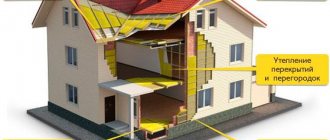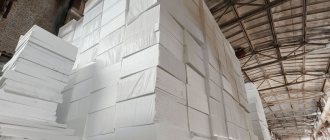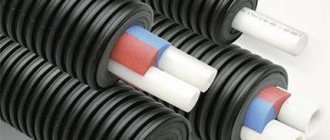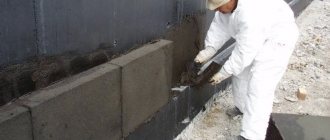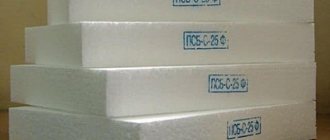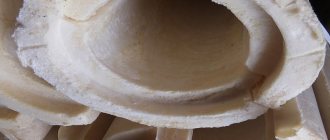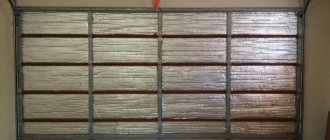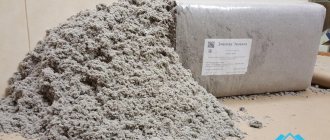Low density and light weight, excellent thermal characteristics and good sound insulation make polystyrene foam one of the most popular thermal insulation materials. Modern technologies make it possible to produce various types of foam, which differ in characteristics, cost and purpose. Knowing the differences will help you choose the optimal material for various jobs.
Polystyrene foam is, first of all, an excellent heat and sound insulator. A small layer of such a heat insulator can retain heat inside buildings even in the coldest winters. Almost everything can be insulated with this material: external and internal walls, roofs, floors and even pipelines. Due to its low weight, even a thick layer of foam does not exert a significant load on the floors, supporting structures or foundation.
Foam plastic - what is it?
Foam plastic is a whole class of materials used in many industries: mechanical engineering, construction, healthcare, gardening and even beekeeping.
Polystyrene foam as a container for the food industry
The foam is based on ultra-light plastic gas-filled plastics obtained from various synthetic polymers. The name of a specific type of foam is determined depending on what polymer or resin the material is made from.
One of the classifications of foam plastics is based on the type of polymer or resin used:
- alkene - from polyethylene and polypropylene;
- urea - from urea-formaldehyde resins (Penoizol);
- polyvinyl chloride - from polyvinyl chloride resins;
- polystyrene - made from expanding polystyrene with or without the addition of a fire retardant (expanded polystyrene, extruded polystyrene foam);
- polyurethane - made of polyesters and polyisocyanates with the addition of a fire retardant (polyurethane foam insulation);
- phenolic - from resol or novolac phenol-formaldehyde resins and phenolic alcohols.
Thus, polystyrene foam is a general term for foamed plastics, and polystyrene foam is one of the types of polystyrene foam, just like polyurethane foam and Penoizol.
All types of foam plastic have a low thermal conductivity coefficient and, as a result, have excellent thermal insulation qualities, which is why they are used for wall insulation.
Almost all foam plastics release very toxic substances during combustion. This imposes certain restrictions on their use in the construction of residential buildings.
Polymers suitable for foaming and blowing agents
Most known polymers can be filled with gases to produce foam plastic. At the same time, the industry produces large-scale foam plastics mainly on the basis of polystyrene (foamed polystyrene, EPS), polyethylene (foamed PE), polyvinyl chloride (foamed PVC), polyurethanes (PPU), polypropylene (foamed PP). Less commonly used are polyreactive materials, like polyurethane foam, such as epoxy, urea, phenolic resins, as well as organosilicon polymers.
Mainly, when foaming in industry, the following gas generators are used: containing nitrogen (azo compounds, nitro compounds, ammonium carbonate, etc.) and low-boiling liquids - isopentane, varieties of freon, methylene chloride.
What is foam made from?
Polystyrene foam can be made from any polymers (plastics). The most well-known raw materials are polyurethane, polyvinyl chloride, phenol-formaldehyde, polystyrene and others. But no matter what plastic the material is made of, it contains only 2% of it, the rest is atmospheric air. Domestic building materials are produced in accordance with GOST 15588-2014 and are designated by the general marking PSB, to which are added numbers and letters that indicate additional properties: low density, self-extinguishing, universal and others. The raw material for expanded polystyrene looks like translucent beads with a diameter of 0.2 to 3.7 mm. The material is produced in several stages:
- Foaming.
- Drying.
- Stabilization.
- Cutting.
- Maturation.
- Baking.
One of the methods involves, after stabilization, moving on to baking, bypassing the 2 previous stages. Not so long ago, a modern version of the material appeared on the market - extruded foam. It differs from the classic one in the smaller size of the cells and their complete closure. This material was considered more technologically advanced, but ordinary polystyrene foam is still the most in demand; it can be used as insulation for walls made of any materials: wall blocks, concrete monolith, wood, brick and much more.
Specifications
ParametersValuesComments
| Compressive strength at 10% linear deformation | From 0.05 to 0.16 mPa | Strength indicators directly depend on the polymer from which the foam is made. For example, phenol-formaldehyde has higher strength values. |
| Thermal conductivity | From 0.038 to 0.043 W/mGrad | The parameter also depends on the brand of building material. |
| Frost resistance | Up to 200 cycles – regular Up to 500 cycles – extruded | Characteristic values depend on the brand |
| Water absorption | 1% per day | Tests showed: 3% of the volume for 1 month of complete immersion in water. The parameters are insignificant, however, if moisture gets into the polystyrene foam, it can subsequently freeze when cold weather sets in. |
| Vapor permeability, coefficient | 0.03 mg/mhPa | This building material does not create natural air exchange between indoors and outdoors. |
| Fire resistance | Flammability G3-G4 Flammability B2-B3 Smoke generation D3 | Expanded polystyrene is considered a highly flammable material |
| Cost of foam | On average 3 thousand rubles per 1 m3. | Polystyrene foam is quite affordable, the price depends on the brand and thickness. |
| Soundproofing | Depending on the thickness, it can increase protection up to 32 dB | Expanded polystyrene is characterized by high performance, but is inferior to other materials, for example, mineral wool |
| Environmental friendliness | Safe | It has no radioactivity and is completely recycled, since no toxic raw materials are used in production and a minimum of energy is consumed. |
| Life time | From 13 to 80 years | The value of the indicator depends on the manufacturer, production technology and raw materials. |
| Foam density | From 11 to 40 kg/m3 | The characteristics depend on the brand. |
Standard sizes of polystyrene foam - thickness varies from 20 to 100 mm, length and width: 1000*1000, 1000*1200, 1200*1200. How much foam plastic costs depends on the dimensions.
Peculiarities
This building material is widely used due to the following qualities:
- the ease of processing of building materials allows you to create structures of any geometry, even the most complex;
- low strength and high compressive density;
- it maintains structure stability in a wide temperature range: from -170 to +80 degrees;
- high resistance to many chemicals and biological factors;
- high thermal insulation allows us to consider polystyrene foam insulation an excellent building material, for example, for the construction of modern multi-layer house structures;
- environmentally friendly building material, since it does not contain substances that are toxic or harmful to human health;
- easy to process and install, including using conventional construction adhesives.
- the price of non-extruded foam is lower than that of EPS.
Flaws
- limited mechanical strength necessitates the formation of protection after installation;
- is destroyed upon contact with paints and varnishes and nitro paints;
- building material can be damaged by rodents, so it must be covered with substances that are less attractive to animals;
- the material almost does not allow air to pass through, which makes it necessary to equip the building with ventilation systems;
- Applying plaster to foam requires preliminary preparation to ensure better adhesion.
Advantages
If all installation rules are followed, liquid foam will last more than 50 years without defects. Other arguments in favor of insulation such as Liquid Penoplast:
- Fire safety;
- adhesion (bonds, connection) with solid materials (concrete, stone);
- natural composition, safe for human health;
- fire resistance;
- reasonable price;
- wide range of permissible temperatures;
- static dimensions, no swelling after hardening;
- low consumption over large areas;
- minimizing the risk of surface damage by microorganisms or insects.
The material does not require preliminary thorough preparation of the surface, which significantly reduces time and money costs. To apply foam with your own hands, you will need a hose (diameter of at least 30 mm). With its help, the substance reaches the most inaccessible places. Insulation using the “old-fashioned” method (using foam rubber) has long since sunk into oblivion due to its ineffectiveness.
Interesting fact: the quality indicators of vapor permeability make it possible to successfully use liquid foam to protect wood coverings, walls, and facades.
Scope of application
This material is widely used in various fields of human activity: packaging for products, furniture production, tailoring, outdoor advertising, shipbuilding, electrical engineering and radio. But polystyrene foam is most in demand in the construction industry:
- Polystyrene foam is a building thermal insulation material that can be used to insulate the outside walls of a house.
- Thermal insulation of roofs and floors.
- As insulation of utility lines.
- For soundproofing between floors or rooms.
- Polystyrene foam is used for insulation on the base, covering it with cladding, and also for thermal insulation of the foundation.
Foam grades depending on density and their application
The numbers in the foam marking indicate its density; the higher the number, the greater the density.
Polystyrene foam grade PPT-10 is used for:
- insulation of construction cabins, trailers and containers;
- thermal insulation of water pipes (protecting them from freezing and increasing service life).
Foam plastic grade PPT-15 is used for:
- sound and thermal insulation of internal walls;
- insulation of balconies and loggias;
- insulation of houses, apartments and other premises;
- sound insulation and insulation of structures that do not experience significant mechanical loads;
- thermal insulation of water pipes (protecting them from freezing and increasing service life).
Polystyrene foam grade PPT-20-A is used for:
- thermal insulation of building facades;
- production of decorative and finishing materials.
Polystyrene foam grade PPT-25 is used for:
- sound and thermal insulation of internal and external walls;
- thermal insulation of foundations and floors;
- thermal insulation of attic floors and ceilings;
- sound and thermal insulation of attic rooms and roofs;
- insulation of balconies and loggias, facades of houses and apartments;
- manufacturing structures of multilayer panels (including reinforced concrete);
- arrangement of access areas, heated paths, car bays, parking lots;
- hydro and thermal insulation of underground communications;
- protection of soils from swelling and freezing;
- thermal insulation of water pipes;
- thermal insulation of sewage drains;
- strengthening the slopes of swimming pools, sports grounds, flower lawns.
Polystyrene foam grade PPT-35 is used:
- for internal and external sound and thermal insulation of walls;
- for sound and thermal insulation of foundations and floors;
- for sound and heat insulation of attic rooms and roofs;
- for insulation of facades of apartments and houses, loggias and balconies;
- when arranging the floors and walls of refrigeration chambers in multi-storey refrigerators;
- for thermal insulation of heated soils, ventilated undergrounds in auto repair shops;
- when laying or reconstructing highways in wetlands and moving soils;
- during installation of refrigeration equipment (refrigerated cars, freezing units) and cold insulation of warehouse premises;
- to protect foundations from freezing and increase their strength during the construction of highways and runways;
- when laying and repairing railway lines (protection from frost, protection from distortions and subsidence of roads on marshy soils);
- for covering the soil in the process of strengthening bridge ledges and embankment slopes.
The foam marking is supplemented with conventional letter symbols:
- A - a plate with smooth edges in the shape of a parallelepiped;
- B - the slab has edges in the form of an L-edge;
- P - a plate cut to its outer size using a hot string;
- F - a plate made to the outer size in a special shape;
- H is a foam board intended for outdoor use.
Here is an example of what the foam plastic marking looks like: PPT-35-N-A-R 1000x500x50mm.
Types of foam
Divided into the following types:
- polystyrene;
- polyethylene;
- polyvinyl chloride;
- polyurethane.
Polystyrene
There are two ways to produce this type of foam:
- Pressless . This variety is familiar to every person. When buying home appliances, you can pay attention to the fact that they are packaged in foam plastic, consisting of small balls fastened together. It is very fragile and can be crushed and broken by hand.
- Press . But this type will be much more difficult to crumble. The granules of such foam are more tightly bonded to each other. The production technology is much more complex and more expensive than that of the non-press type, so it is much less common.
There is such a variety as extruded foam , it is practically no different from non-pressed foam.
Polystyrene types of foam have one significant disadvantage - high hygroscopicity .
We recommend: Linoleum flooring, what it is, types, characteristics. How to choose the right one for your home?
Water vapor enters the cavities that are located between the “balls” and granules.
This material “does not breathe”, so the steam does not escape anywhere and when exposed to sub-zero temperatures it can freeze, destroying the structure.
Even in the absence of exposure to cold, the accumulated steam worsens the thermal insulation properties of the foam and increases the humidity in the room.
Extruded foam plastic does not have such disadvantages, since it is homogeneous in its structure . It is common in the production of disposable cutlery, tableware, and food packaging.
As for the durability of polystyrene foam, we can say that for non-pressed foam it will range from 10 to 35 years . Extrusion will last much longer, about 50-70 years . Of course, the service life directly depends on the manufacturer of the material and the impact of destructive factors at the installation site.
Polyurethane
One example of polyurethane foam is foam rubber . It has a porous structure, good air and steam permeability, and high elasticity. It is used in furniture production, both as upholstery and as a filler.
Based on it, many household items are made. It is highly flammable and releases hazardous substances that are more toxic than polystyrene foams. The reason for this is hydrocyanic acid in the composition. It is extremely short-lived, turns yellow and is destroyed when exposed to external factors such as ultraviolet radiation.
Polyvinyl chloride
Polyvinyl chloride itself is a thermoplastic polymer that contains up to 56.8% bound chlorine , which makes it difficult to burn. It can be produced using both press and non-press methods. Its properties are similar to extruded polyethylene foam.
It contains no toxic substances. When burning, polyvinyl chloride foam extinguishes on its own.
It is highly elastic, but can corrode metal structures next to which it is located.
Polyethylene
It occurs quite often in everyday life. It looks like a translucent film consisting of air pimples.
It is used for wrapping fragile items and easily damaged equipment and does an excellent job of protecting against damage.
Polyethylene foam is very elastic and has different thicknesses, from a few millimeters to several centimeters. It is similar in strength to extruded polystyrene foam, but its distinctive feature is its non-toxicity. It is considered an environmentally friendly material with a long service life. Flammable.
Foam figures
Start your training by creating various foam figures. Make large chess pieces. We assure you - this is an excellent training for manual dexterity. Further ideas will appear on their own. It’s enough to remember how you worked on chess queens.
Remember that it is possible to make not only three-dimensional models, but also flat ones. Products in the form of birds and other animals look very interesting. If you use trowels to cut out a bird, paint it and hang it from the ceiling, we assure you that everyone will notice the unusual craft and ask a question about it.
If you are lucky enough to have a pond on your property, then think about patterns of fish and frogs. They can be safely released into the water; the foam does not release any toxins or chemicals in its normal state. In addition, due to its low density, it will not sink and will look very unusual.
Children may be of particular interest. Create figures of hares, squirrels and bears with your children. Let them demonstrate the products in class/
Decoration materials
To create the decorations you will need:
- Foam plastic (you will have to choose the density yourself, depending on your ideas)
- Utility knife and replacement blades
- Sandpaper
- Glue and paints for shaping
It is much easier to make flat figures; you need to think in one plane. But volumetric ones are much more complicated. The processing of each side requires a previously recorded production plan. Also, getting used to the material may take time.
Therefore, you should study and train on flat products. To do this, choose any drawing and make a stencil from it. Transfer it to the foam and all that remains is to cut out the shape using a stationery knife. The edges will likely be uneven, so use sandpaper and smooth out until smooth.
All parts of your craft can be fastened not only with glue, but also in any physical way. For small products, use toothpicks; for larger ones, you can use thread.
Foam bird
We turn to the Internet and draw a template on foam plastic. Using a sharp knife, cut out the contours and cover the resulting figure with putty. This is required to keep the bird outside. Putty is sufficient in two layers; after the first layer has completely dried, the second is applied immediately. This will give the maximum and necessary strength to the product. Remove any unevenness caused by the putty using sandpaper.
We start painting the product and use paint intended for facade work. The paint protects the foam from the final coat of varnish. After painting is completed and the product has dried, we look for feathers of different colors and attach them to the bird. With such actions you can achieve a great resemblance to a real bird.
Links
- [www.youtube.com/watch?v=tNNRpMq0UAw Obtaining polystyrene foam, video]
- [penoplast.biz.ua/penoplast/plotnost-penoplasta.html Foam density]
| : Incorrect or missing image | To improve this article it is desirable:
|
Recycling Expandable Polystyrene
The production of polystyrene foam from foaming polystyrene occurs in three stages:
- Pre-foaming.
- Intermediate aging (ripening).
- Final foaming with molding.
At each stage, quality control is required according to certain parameters.
Pre-foaming
During pre-foaming, the granules expand under the influence of saturated steam. The granules are heated at a temperature of 80 – 110ᵒС. Depending on the steam pressure and processing time, the density of polystyrene decreases from 630 kg/m. cube up to 15-30 kg/m. cube The density of the pre-foaming is determined by the final density of the finished product.
Most commonly for building blocks, granules can be re-foamed after an intermediate aging period of 4-6 hours to produce a low-density finished product. Double foaming is used to achieve low bulk density - 15 kg/m. cube and below.
During primary pre-foaming, a bulk density is obtained that is 1.5 times lower than the desired final density in the finished product. The pentane contained in the initial granules inflates them to 50 times their original volume, which leads to the formation of foam granules with closed cells. The size of the granules after pre-foaming is 3.6-6 mm.
Maturing of granules - preliminary exposure
Intermediate storage in silos, during which pentane and water vapor condense in the cells, creating a vacuum, promotes the diffusion of air into the cells. At the same time, hardening of the polystyrene occurs. The holding time is usually from 6 to 24 hours, depending on the brand of polystyrene and the ambient temperature.
The granules are dried (after foaming, the residual moisture content is up to 5%), excess pentane is released from them, and they are stabilized in well-ventilated silos. Drying is carried out in warm rooms without drafts, otherwise the granules may “collapse”. After all, the thin cell walls of newly foamed material are especially sensitive to additional environmental pressure and temperature changes. Therefore, pre-foamed polystyrene is stabilized immediately after foaming.
For the same reason, it is necessary to avoid mechanical damage to the granules during transportation from the pre-expander to the silos. The recommended linear feed speed of the material is no more than 8 m/s.
Therefore, pneumatic feed with controlled speed has proven itself best. Pipelines must be without sharp bends to prevent injury to the granules.
Polystyrene foam molding
Then the pre-foamed granules are poured into vacuum molds, where, when treated with cross steam, under the influence of a steam boost under vacuum, they soften and expand, and are welded together by pressing. This is a thermal, but not a chemical process. The finished product is cooled with water and removed from the mold. That is, in the manufacture of finished products from polystyrene foam, no additional chemicals, such as resins, are used.
This produces a molded foam with a high air content contained in a huge number of closed cells, which is the reason for high and stable thermal insulation. Residual pentane continues to leave the cells for at least another day. During curing, the granules are strengthened, as polymerization processes continue to occur in heated polystyrene.
The influence of polystyrene foam on human health
Questions about whether polystyrene foam is harmful to health or not have worried consumers almost from the very beginning of its use. Each new finishing and building material based on foam plastic caused a renewal of these disputes.
Proponents of the use of expanded polystyrene cite the research of scientists - chemists, physicists and materials scientists - as a safety argument. Expanded polystyrene, without external influences on it, practically does not interact with the environment.
Its molecular structure is very stable. The experiments described above show that under normal human conditions, polystyrene foam does not emit any harmful substances. Actually, it does not release any substances.
Might be interesting
Opponents of the use of expanded polystyrene claim the possibility of styrene release. Even if not under ordinary, but under extreme conditions. Extreme conditions refer to exposure to high temperatures. Indeed, when burned, polystyrene foam, like many other substances, releases a large amount of toxic substances, among which styrene is considered especially toxic.
Effect of styrene on humans:
- dizziness;
- irritation of the mucous membranes of the eyes;
- high concentrations lead to lung damage and even fatal poisoning;
- the functioning of the kidneys, liver, and hematopoietic system is disrupted;
- oncology.
The flammability of the initially created polystyrene foam was quite high. At temperatures above 210 °C, the foam was able to independently support surface combustion and spread fire. That is why fire retardants (substances that inhibit ignition and flame spread) are now used for the production of construction and finishing polystyrene foam.
Thanks to this, it was possible to reduce flammability and increase the ignition temperature to 440 °C. In addition, most modern polystyrene foam products do not allow flames to spread and do not support spontaneous combustion.
It must be said that, like many other substances that are dangerous in large doses, but harmless in small doses, styrene is naturally found in many products that we use every day - coffee, tea, cinnamon, cheese, strawberries and so on.
Melting polystyrene foam
The harm of expanded polystyrene to human health may also be associated not so much with the qualities of the material, but with its improper use in finishing. Expanded polystyrene is a very popular thermal insulator, but at the same time it does not allow steam and moisture to pass through. It happens that people, out of ignorance or out of economy, insulate the walls between the apartment and the street from the inside with sheets of expanded polystyrene.
This situation is serious because the moisture in the warm home air collides with the cold wall directly under the foam and condenses there. The wall on the concrete surface is constantly wet, which will inevitably lead to the development of fungus and black mold, the spores of which are a dangerous allergen. Black mold can trigger the development of asthma, chronic bronchitis and other diseases.
Do-it-yourself material recycling
If you want to know exactly how you can recycle polystyrene foam, we suggest you consider the step-by-step instructions. All you need is enough foam and a crusher. Then you can get polystyrene foam granules and use them for your own purposes. If you don’t have your own foam crusher, you can make one yourself. After all, factory models have a very high price.
Here's what you'll need to have a new useful tool on your farm:
- sewer PVC pipe, diameter 50 mm;
- tape measure and marker;
- metal file;
- a wooden beam that would fit inside the pipe;
- metal screws;
- screwdriver and drill;
- metal studs with bolts;
- Chipboard or plywood to create a box.
Using this set of tools and materials, you can create a working foam crusher. With its help, sheets or other foam crafts will turn into crumbs. The mechanism is based on a moving part with teeth, which crush the foam into granules. And thanks to the container or box, it is easier to direct the material to the rotating mechanism. You will learn exactly how to create a crusher in this video.
So, when the crusher is ready, you can start working. Here's what to do:
- Choose a suitable location. Alternatively, choose a garage, warehouse, storage room or shed.
- Install the crusher, taking care of the container underneath it, where the crumbs will fall. This could be a bucket, bag or wooden box.
- Foam sheets are easy to crush. But as for figured products, it is better to break them into pieces with your hands in advance.
- Now all that remains is to turn on our homemade unit and gradually process the raw materials.
Thanks to this technology, most of the granules will remain intact. This means that they will cope with their task better than ever. You just need to be careful, as the foam is electrified and very light. It is important to make sure that there are no drafts in the room, otherwise you will have to remove everything from the floor later. Now the foam can be collected in bags and used immediately or stored until it has its time.
Note! If you melt the foam with acetone, it can be used in liquid form as glue. Although the mixture cannot be called safe.
Thermal insulation of engineering systems
Foam plastic has become very often used for thermal insulation of engineering systems. For example, for thermal insulation of water and sewer pipes during winter freezing, the use of polystyrene foam will be simply irreplaceable, as it will help to avoid the catastrophe of pipe breakage in the winter. Foam plastic is also used for thermal insulation of cold water supply pipes. Ventilation ducts, telephone lines and recessed ducts are also insulated with foam.
If you notice an error, a non-working video or link, please select a piece of text and press Ctrl+Enter .
0
Safety measures in the production of polystyrene foam
The production of expanded polystyrene is a fire and explosion hazardous industry and requires certain safety measures. Pentane, which is actively released during pre-foaming and curing of polystyrene in silos, is heavier than air and accumulates at the floor level of production premises. Therefore, it is necessary to provide intrinsically safe equipment and pipelines, as well as sensors that monitor safe levels of pentane.
Places where pentane accumulates are raw materials warehouses, storage facilities and finished product storage areas.
So, security measures:
- It is necessary to provide at least 2 escape routes.
- Storage areas for pellets and finished products should be separated by fire walls.
- The optimal temperature in the silo is 24 ᵒC.
- The volume of the silo should be 2-2.5 times greater than the daily production rate.
- Store the material at a temperature not lower than 20 ᵒC and a relative humidity of at least 70%.
- Walls and floors must be made of fire-resistant materials, and all processing equipment must be spark-proof.
- Passages – at least 1.2 m.
- Flame and smoke sensors and automatic fire extinguishing system.
There are cases where polystyrene foam production facilities burned down in 12 seconds. For this reason, the processing of expanded polystyrene is located in separate buildings
